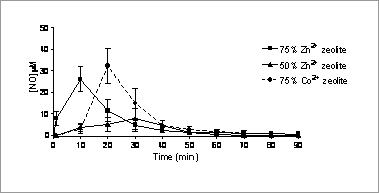Print version
Search Pub Med
Nitric oxide-loaded Co2+ and Zn2+-exchanged zeolites have powerful anti-aggregatory properties in human platelets Endothelium derived nitric oxide (NO) is a potent inhibitor of platelet activation (Radomski et al 1987). Polymers incorporating NO donating substances (e.g. diazeniumdiolates) have shown potential as antithrombotic surface coatings (Frost et al 2005), but have limited NO capacities. Zeolites are nanoporous solids that might offer an alternative to polymer-based antithrombotic coatings because they can act as high capacity storage materials for gases, including NO. The chemical characteristics of zeolites are easily manipulated by altering the specific cation, the porosity of the zeolite and the binding material in which it is embedded. In this study, we investigated the NO release properties of Zn 2+ and Co 2+ cation-exchanged zeolites in human plasma, and determined the extent and duration of their antiplatelet activity. NO-loaded Zn 2+ and Co 2+-exchanged zeolites of various compositions (10%-75%) in polytetrafluoroethylene binder (PTFE; pressed into 3 mm dia. discs) were found to generate substantial NO for ~60 min upon immersion in platelet-rich plasma (PRP; 1 ml, 37 oC; n=6). The NO-release profile was dependent on both the exchanged cation (Zn 2+ or Co 2+) and the composition of zeolite:PTFE binder (see Fig. 1).

Fig. 1: NO generation from Zn 2+and Co 2+-exchanged zeolites (50-75%: PTFE) in PRP Turbidometric platelet aggregometry was used to determine the ability of NO-loaded zeolites to inhibit collagen induced platelet aggregation in PRP in vitro. Discs (3 mm dia.) containing NO-loaded Zn 2+ and Co 2+ ion-exchanged zeolites (10-75% in PTFE binder) were suspended in PRP (500 µl; 37ºC; 1-80 min) before stimulation with collagen (2.5µl.ml -1). Zn 2+ exchanged zeolite (≥50%) and Co 2+ exchanged zeolite (75% only) significantly inhibited platelet aggregation throughout the incubation period (80 min; p<0.01; n=6-8); NO-free counterparts failed to alter platelet aggregation over the same period, indicating the essential role of NO in the effect. Our results suggest that Co 2+ and Zn 2+-exchanged zeolites are high capacity storage materials of NO with powerful antiplatelet activity in vitro. The NO release profiles and antiplatelet effects were dependent on the specific cation exchanged and on the relative proportion of zeolite:PTFE binder. These zeolites will act as prototypes for the development of zeolites with optimal NO release capacities lasting for considerably longer durations.
Frost M.C. et al (2005) Biomaterials 26,1685 -1693. |

